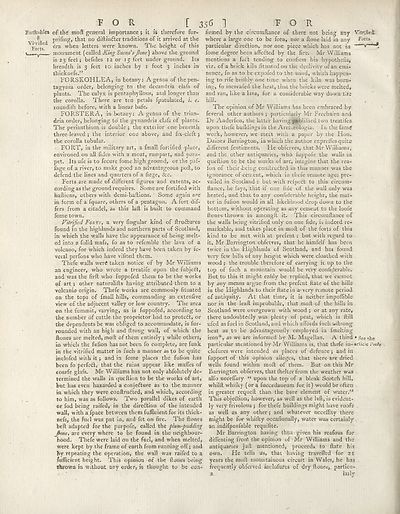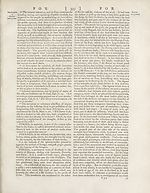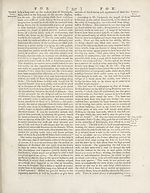Encyclopaedia Britannica > Volume 7, ETM-GOA
(386) Page 356
Download files
Complete book:
Individual page:
Thumbnail gallery: Grid view | List view

FOR [ 356 ] FOR
Forlkuhlea of the mo ft general importance ; it is therefore fur-
. if prifing, that no diftinfter traditions of it arrived at the
Ports'5 era wiien letters were known. The height of this
‘ t monument (called King Bueno'sJione) above the ground
is 23 feet; befides 12 or 15 feet under ground. Its
breadth is 3 feet 10 inches by 1 foot 3 inches in
thicknefs.”
FORSKOHLEA, in botany: A genus of the pen-
tagynia order, belonging to the decandria clafs of
plants. The calyx is pentaphyllous, and longer than
the corolla. There are ten petals fpatulated, /. e.
roundilh before, with a linear bafe.
FORSTERA, in botany: A genus of the trian-
dria order, belonging to the gynandria clafs of plants.
The perianthium is double ; the extenor one beneath
three-leaved ; the interior one above, and fix-cleft;
the corolla tubular.
FORT, in the military art, a fmall fortified place,
environed on all fides with a moat, rampart, and para¬
pet. Its ufe is to fecure fome high ground, or the paf-
fage of a river, to make good an advantageous poft, to
defend the lines and quarters of a fiege, &c.
Forts are made of different figures and extents, ac¬
cording as the ground requires. Some are fortified with
baftions, others with demi-baftions. ' Some again are
in form of a fquare, others of a pentagon. A fort dif¬
fers from a citadel, as this lalt is built to command
fome town.
Vitrified Forts, a very Angular kind of ftru&ures
found in the highlands and northern parts of Scotland,
in which the walls have the appearance of being melt¬
ed into a folid mafs, fo as to refemble the lava of a
volcano, for which indeed they have been taken by fe-
veral perfons who have vilited them.
Thefe walls weri taken notice of by Mr Williams
an engineer, who wrote a treatife upon the fubjeft,
and was the firil who fuppofed them to be the works
©f art ; other naturalifts having attributed them to a
volcanio origin. Thefe works are commonly fituated
on the tops of fmall hills, commanding an extenfive
view of the adjacent valley or low country. The area
©n the fummit, varying, as is fuppofed, according to
the number of cattle the proprietor had to proted, or
the dependents he was obliged to accommodate, is fur-
rounded with an high and llrong wall, of which the
ftones are melted, moft of them entirely ; while others,
in which the ftifton has not been fo complete, are funk
in the vitrified matter in fuch a manner as to be quite
inclofed with it; and in fome places the fufion has
been fo perfedt, that the ruins appear like maffes of
eoarfe glafs. Mr Williams has not only abfolutely de¬
termined the walls in queflion to be the works of art,
but has even hazarded a conje&ure as to the. manner
in which they were conftrudted, and which, according
to him, was as follows. Two parallel dikes of earth
©r fod being raifed, in the dire&ion of the intended
wall, with a fpace between them fufficient for its thick¬
nefs, the fuel was put in, and fet oh fire. The ftones
beft adapted for the purpofe, called the plum-pudding
Jione, are every where to be found in the neighbour¬
hood. Thefe were laid on the fuel, and when melted,
were kept by the frame of earth from running off; and
by repeating the operation, the wall was raifed to a
fufficient height. This opinion of the ftones being
thrown in without any order, is thought to be con¬
firmed by the circumftance of there not being any Vitrifiei
where a large one to be feen, nor a ftone laid in any Forts,
particular diredtion, nor one piece which has not in '—
fome degree been affedted by the fire. Mr Williams
mentions a fadt tending to confirm his hypothefis,
viz. of a brick kiln fituated on the declivity of an emi¬
nence, fo as to be expofed to the wind, which happen¬
ing to rife brrikly one time when the kiln was burn¬
ing, fo increafed the heat, that the bricks were melted,
and ran, like a lava, for a coniiderable way down til;
hill.
The opinion of Mr Williams has been embraced by
feveral other authors ; particularly Mr Freebairn and
Dr Anderfon, the latter having pmbli fned two treatifes
upon thefe buildings in the Archaeologia. In the fam<5
work, however, we meet vvich a paper by the Hon.
Dailies’ Barrington, in which the author expreffes quite
different fentiments. Fie obferves, that Mr Williams,
and the other antiquaries, who fuppofe the walls in
queftion to be the works of arc, imagine that the rea-
fon of theirieing conftrudted in this manner was the
ignorance of cement, which in thefe remote hges pre¬
vailed in Scotland : but with refpedt to this circum-
ftance, he fays, that if one fide of the wall only was
heated, and that to any confiderable height, the mat¬
ter in fufion would in all likelihood drop down to the
bottom, without operating as any cement to the loofe
ftones thrown in amongft it. This circumftance of
the walls being vitrified only on one fide, is indeed re¬
markable, and takes place in moft of the forts of this
kind to be met with at prefent : but with regard to
it, Mr Barrington obfervss, that he himfelf has been
twice in the Highlands of Scotland, and has found
very few hills of any height which were cloathed with
wood ; the trouble therefore of carrying it up to the
top of fuch a mountain would be very confiderable.
But to this it might eafdy be replied, that we cannot
by any means argue from the prefent ftate of the hills
in the Highlands to their ftate in a-very remote period
of antiquity. At that time, it is neither impoffihle
nor in the leaft improbable, that moft of the hills in
Scotland were overgrown with wood ; or at any rate,
there undoubtedly was plenty of peat, which is ftill
ufed as fuel in Scotland, and which affords fuch a»ftrong
heat as to be advantageoufly employed in fmelting
iron*, as we are informed by M. Magellan. A third • See the
particular mentioned by Mr Williams is, that thefe in-articie iW# .
clofures were intended as places of defence; and in
fupport of this opinion alleges, that there are dried
wells found within moft of them. But on this Mr
Barrington obferves, that ffielter from the weather was
alfo neceffary “ upon the top of a bleak Scotch hill,
whilft whilky (or a fuccedaneum for. it) would be often
in greater requeft than the bare element of water.’*
This objedion, however, as well as the laft, is evident¬
ly very frivolous ; for thefe buildings might have roofs
as well as any other; and whatever neceffity there
might be for- whilky occafionally, water was certainly
an indifpenfable requifite.
Mr Barrington having thus given his reafons for
diffenting frorrt the opinion of Mr Williams and the
antiquaries juft mentioned, proceeds to ftate his
own. He tells us, that having travelled for 21
years the moft mountainous circuit in Wales, he has
frequently obferved inclofures of dry ftones,. particu-
3 laily
Forlkuhlea of the mo ft general importance ; it is therefore fur-
. if prifing, that no diftinfter traditions of it arrived at the
Ports'5 era wiien letters were known. The height of this
‘ t monument (called King Bueno'sJione) above the ground
is 23 feet; befides 12 or 15 feet under ground. Its
breadth is 3 feet 10 inches by 1 foot 3 inches in
thicknefs.”
FORSKOHLEA, in botany: A genus of the pen-
tagynia order, belonging to the decandria clafs of
plants. The calyx is pentaphyllous, and longer than
the corolla. There are ten petals fpatulated, /. e.
roundilh before, with a linear bafe.
FORSTERA, in botany: A genus of the trian-
dria order, belonging to the gynandria clafs of plants.
The perianthium is double ; the extenor one beneath
three-leaved ; the interior one above, and fix-cleft;
the corolla tubular.
FORT, in the military art, a fmall fortified place,
environed on all fides with a moat, rampart, and para¬
pet. Its ufe is to fecure fome high ground, or the paf-
fage of a river, to make good an advantageous poft, to
defend the lines and quarters of a fiege, &c.
Forts are made of different figures and extents, ac¬
cording as the ground requires. Some are fortified with
baftions, others with demi-baftions. ' Some again are
in form of a fquare, others of a pentagon. A fort dif¬
fers from a citadel, as this lalt is built to command
fome town.
Vitrified Forts, a very Angular kind of ftru&ures
found in the highlands and northern parts of Scotland,
in which the walls have the appearance of being melt¬
ed into a folid mafs, fo as to refemble the lava of a
volcano, for which indeed they have been taken by fe-
veral perfons who have vilited them.
Thefe walls weri taken notice of by Mr Williams
an engineer, who wrote a treatife upon the fubjeft,
and was the firil who fuppofed them to be the works
©f art ; other naturalifts having attributed them to a
volcanio origin. Thefe works are commonly fituated
on the tops of fmall hills, commanding an extenfive
view of the adjacent valley or low country. The area
©n the fummit, varying, as is fuppofed, according to
the number of cattle the proprietor had to proted, or
the dependents he was obliged to accommodate, is fur-
rounded with an high and llrong wall, of which the
ftones are melted, moft of them entirely ; while others,
in which the ftifton has not been fo complete, are funk
in the vitrified matter in fuch a manner as to be quite
inclofed with it; and in fome places the fufion has
been fo perfedt, that the ruins appear like maffes of
eoarfe glafs. Mr Williams has not only abfolutely de¬
termined the walls in queflion to be the works of art,
but has even hazarded a conje&ure as to the. manner
in which they were conftrudted, and which, according
to him, was as follows. Two parallel dikes of earth
©r fod being raifed, in the dire&ion of the intended
wall, with a fpace between them fufficient for its thick¬
nefs, the fuel was put in, and fet oh fire. The ftones
beft adapted for the purpofe, called the plum-pudding
Jione, are every where to be found in the neighbour¬
hood. Thefe were laid on the fuel, and when melted,
were kept by the frame of earth from running off; and
by repeating the operation, the wall was raifed to a
fufficient height. This opinion of the ftones being
thrown in without any order, is thought to be con¬
firmed by the circumftance of there not being any Vitrifiei
where a large one to be feen, nor a ftone laid in any Forts,
particular diredtion, nor one piece which has not in '—
fome degree been affedted by the fire. Mr Williams
mentions a fadt tending to confirm his hypothefis,
viz. of a brick kiln fituated on the declivity of an emi¬
nence, fo as to be expofed to the wind, which happen¬
ing to rife brrikly one time when the kiln was burn¬
ing, fo increafed the heat, that the bricks were melted,
and ran, like a lava, for a coniiderable way down til;
hill.
The opinion of Mr Williams has been embraced by
feveral other authors ; particularly Mr Freebairn and
Dr Anderfon, the latter having pmbli fned two treatifes
upon thefe buildings in the Archaeologia. In the fam<5
work, however, we meet vvich a paper by the Hon.
Dailies’ Barrington, in which the author expreffes quite
different fentiments. Fie obferves, that Mr Williams,
and the other antiquaries, who fuppofe the walls in
queftion to be the works of arc, imagine that the rea-
fon of theirieing conftrudted in this manner was the
ignorance of cement, which in thefe remote hges pre¬
vailed in Scotland : but with refpedt to this circum-
ftance, he fays, that if one fide of the wall only was
heated, and that to any confiderable height, the mat¬
ter in fufion would in all likelihood drop down to the
bottom, without operating as any cement to the loofe
ftones thrown in amongft it. This circumftance of
the walls being vitrified only on one fide, is indeed re¬
markable, and takes place in moft of the forts of this
kind to be met with at prefent : but with regard to
it, Mr Barrington obfervss, that he himfelf has been
twice in the Highlands of Scotland, and has found
very few hills of any height which were cloathed with
wood ; the trouble therefore of carrying it up to the
top of fuch a mountain would be very confiderable.
But to this it might eafdy be replied, that we cannot
by any means argue from the prefent ftate of the hills
in the Highlands to their ftate in a-very remote period
of antiquity. At that time, it is neither impoffihle
nor in the leaft improbable, that moft of the hills in
Scotland were overgrown with wood ; or at any rate,
there undoubtedly was plenty of peat, which is ftill
ufed as fuel in Scotland, and which affords fuch a»ftrong
heat as to be advantageoufly employed in fmelting
iron*, as we are informed by M. Magellan. A third • See the
particular mentioned by Mr Williams is, that thefe in-articie iW# .
clofures were intended as places of defence; and in
fupport of this opinion alleges, that there are dried
wells found within moft of them. But on this Mr
Barrington obferves, that ffielter from the weather was
alfo neceffary “ upon the top of a bleak Scotch hill,
whilft whilky (or a fuccedaneum for. it) would be often
in greater requeft than the bare element of water.’*
This objedion, however, as well as the laft, is evident¬
ly very frivolous ; for thefe buildings might have roofs
as well as any other; and whatever neceffity there
might be for- whilky occafionally, water was certainly
an indifpenfable requifite.
Mr Barrington having thus given his reafons for
diffenting frorrt the opinion of Mr Williams and the
antiquaries juft mentioned, proceeds to ftate his
own. He tells us, that having travelled for 21
years the moft mountainous circuit in Wales, he has
frequently obferved inclofures of dry ftones,. particu-
3 laily
Set display mode to:
![]() Universal Viewer |
Universal Viewer | ![]() Mirador |
Large image | Transcription
Mirador |
Large image | Transcription
Images and transcriptions on this page, including medium image downloads, may be used under the Creative Commons Attribution 4.0 International Licence unless otherwise stated. ![]()
| Encyclopaedia Britannica > Encyclopaedia Britannica > Volume 7, ETM-GOA > (386) Page 356 |
|---|
| Permanent URL | https://digital.nls.uk/189126247 |
|---|
| Attribution and copyright: |
|
|---|
| Description | Ten editions of 'Encyclopaedia Britannica', issued from 1768-1903, in 231 volumes. Originally issued in 100 weekly parts (3 volumes) between 1768 and 1771 by publishers: Colin Macfarquhar and Andrew Bell (Edinburgh); editor: William Smellie: engraver: Andrew Bell. Expanded editions in the 19th century featured more volumes and contributions from leading experts in their fields. Managed and published in Edinburgh up to the 9th edition (25 volumes, from 1875-1889); the 10th edition (1902-1903) re-issued the 9th edition, with 11 supplementary volumes. |
|---|---|
| Additional NLS resources: |
|

